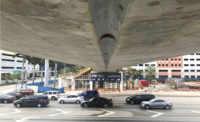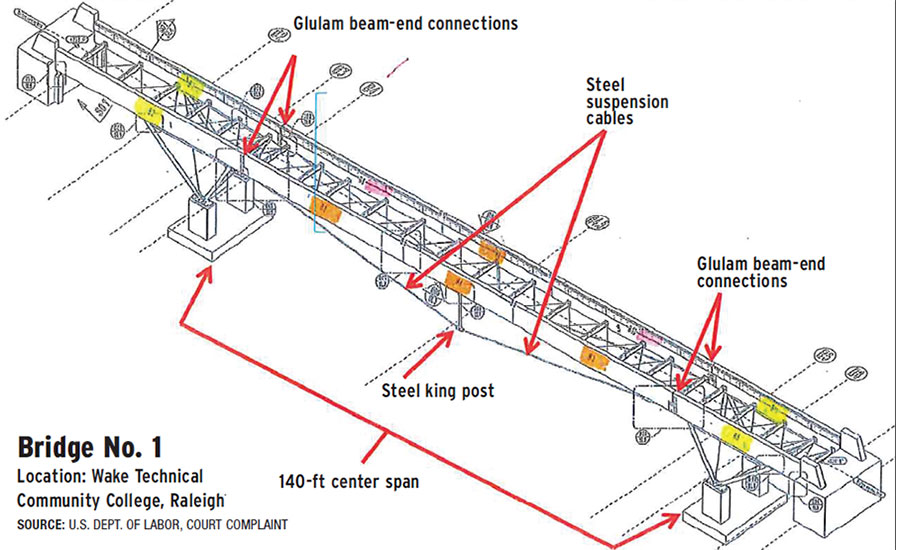Risk Management
Designers Face Fatal Pedestrian Bridge Collapse Fallout
Engineer contests possible license suspension over Wake Technical Community College bridge errors

Timber Span The Occupational Safety and Health Administration determined that the notched end connections in glulam girders was the underlying weakness that caused two pedestrian bridges to collapse. Photo from Wake County, N.C., Court Complaint

Girder Ends This photo in lawsuit shows one of the notched end connections noted by OSHA. Photo courtesy of Steven J. Davis


The use of “severely notched” end connections in the design of timber bridge girders that failed, sending a pair of partly completed pedestrian bridges crashing to the ground—and killing one worker—has come back to haunt the bridge engineer, architect of record and material supplier. The design detail had provoked concerns that were not fully addressed before the November 2014 bridge collapses at Wake Technical Community College in Raleigh, N.C., during an expansion project that involved several buildings and the bridges.
Robert T. Macia, former president of Stewart Engineering, is contesting allegations by the North Carolina Board of Examiners for Engineers and Surveyors that he is “guilty of gross negligence or misconduct.” Macia faces a range of penalties for the design error that could include license suspension or revocation.
Attorneys for the family of Jose Luis Rosales-Nava, a worker employed on the project, are seeking damages from the architect of record, Clark Nexsen, and Structurlam Products LP, the supplier of the glulam girders that failed. The lawsuit, filed on Nov. 10, claims that those two firms were most responsible for the risks associated with the notched girders, the design flaw that the U.S. Occupational Safety and Health Administration determined caused the collapses. Neither Macia nor Stewart Engineering are defendants.
Rosales-Nava was killed during a deck pour on Bridge No. 1, which had a 140-ft central span and a total length of 245 ft. The end spans were supported over V-columns. Both that bridge and the second bridge, which collapsed 12 hours after the first (ENR 12/1/14, p. 12), had through-girder designs consisting of two 13.5-in.-wide by 60-in.-deep glulam beams. Steel-pipe king posts supported each bridge’s center spans over wire cables connected at each end. Notches at each girder end facilitated the connections, according to OSHA’s April 2015 report, but “the notches under the application of a full dead load resulted in the formation of horizontal cracks, eventually leading to the catastrophic failures.”
Because OSHA’s investigation found that Stewart Engineering was responsible only for the design and had no staff on site, OSHA issued no citations against the company. Instead, it referred the issue to the engineering board. In June 2016, the board issued a reprimand to Stewart Engineering and a fine of $5,000. In its ruling, the board stated that Stewart Engineering provided “inadequate QA/QC … [and] should have recognized and raised concerns about the inadequate design and not documenting the completion of QA/QC checks … and employees failed to adequately address communicated concerns with the design.”
Michael Krannitz, senior vice president with Stewart Engineering, told ENR that the firm accepted the finding and penalty “without question.” Krannitz said the firm revised its quality assurance and quality control (QA/QC) procedures “to better establish documentation requirements.” He would not comment on the pending lawsuit.
The lawsuit alleges that the defendants either dismissed concerns about the bridges’ design raised prior to construction or else should have known the design did not meet building codes.
Additionally, the board’s hearing citation alleges that Macia sealed “inadequate design documents,” submitted plans for permitting prior to adequate calculations, failed to adequately address communicated concerns with the design and failed to follow “an adequate QA/QC process.” The board argues this constituted “gross negligence and misconduct.”
Macia did not respond to requests for comment in time for publication.
Architect’s Response
Contacted by ENR about the lawsuit, a representative for Clark Nexsen issued a statement that drew a sharp distinction about the services provided on the project. “Clark Nexsen, Inc. held the contract with Wake Technical Community College and served as the Architect of Record on the project. All engineering services were performed and professionally sealed by licensed engineers with other companies. North Carolina and U.S. Dept. of Labor investigations identified engineers from one of those companies as responsible for the design.”
The representative added that Clark Nexsen plans to file a legal response to the complaint “at the appropriate time.” Structurlam Products did not respond to ENR’s requests for comment.






